Peizhuo Li
Unicorn: A Universal and Collaborative Reinforcement Learning Approach Towards Generalizable Network-Wide Traffic Signal Control
Mar 14, 2025Abstract:Adaptive traffic signal control (ATSC) is crucial in reducing congestion, maximizing throughput, and improving mobility in rapidly growing urban areas. Recent advancements in parameter-sharing multi-agent reinforcement learning (MARL) have greatly enhanced the scalable and adaptive optimization of complex, dynamic flows in large-scale homogeneous networks. However, the inherent heterogeneity of real-world traffic networks, with their varied intersection topologies and interaction dynamics, poses substantial challenges to achieving scalable and effective ATSC across different traffic scenarios. To address these challenges, we present Unicorn, a universal and collaborative MARL framework designed for efficient and adaptable network-wide ATSC. Specifically, we first propose a unified approach to map the states and actions of intersections with varying topologies into a common structure based on traffic movements. Next, we design a Universal Traffic Representation (UTR) module with a decoder-only network for general feature extraction, enhancing the model's adaptability to diverse traffic scenarios. Additionally, we incorporate an Intersection Specifics Representation (ISR) module, designed to identify key latent vectors that represent the unique intersection's topology and traffic dynamics through variational inference techniques. To further refine these latent representations, we employ a contrastive learning approach in a self-supervised manner, which enables better differentiation of intersection-specific features. Moreover, we integrate the state-action dependencies of neighboring agents into policy optimization, which effectively captures dynamic agent interactions and facilitates efficient regional collaboration. Our results show that Unicorn outperforms other methods across various evaluation metrics, highlighting its potential in complex, dynamic traffic networks.
SATA: Safe and Adaptive Torque-Based Locomotion Policies Inspired by Animal Learning
Feb 18, 2025Abstract:Despite recent advances in learning-based controllers for legged robots, deployments in human-centric environments remain limited by safety concerns. Most of these approaches use position-based control, where policies output target joint angles that must be processed by a low-level controller (e.g., PD or impedance controllers) to compute joint torques. Although impressive results have been achieved in controlled real-world scenarios, these methods often struggle with compliance and adaptability when encountering environments or disturbances unseen during training, potentially resulting in extreme or unsafe behaviors. Inspired by how animals achieve smooth and adaptive movements by controlling muscle extension and contraction, torque-based policies offer a promising alternative by enabling precise and direct control of the actuators in torque space. In principle, this approach facilitates more effective interactions with the environment, resulting in safer and more adaptable behaviors. However, challenges such as a highly nonlinear state space and inefficient exploration during training have hindered their broader adoption. To address these limitations, we propose SATA, a bio-inspired framework that mimics key biomechanical principles and adaptive learning mechanisms observed in animal locomotion. Our approach effectively addresses the inherent challenges of learning torque-based policies by significantly improving early-stage exploration, leading to high-performance final policies. Remarkably, our method achieves zero-shot sim-to-real transfer. Our experimental results indicate that SATA demonstrates remarkable compliance and safety, even in challenging environments such as soft/slippery terrain or narrow passages, and under significant external disturbances, highlighting its potential for practical deployments in human-centric and safety-critical scenarios.
Learning-based Hierarchical Control: Emulating the Central Nervous System for Bio-Inspired Legged Robot Locomotion
Apr 27, 2024



Abstract:Animals possess a remarkable ability to navigate challenging terrains, achieved through the interplay of various pathways between the brain, central pattern generators (CPGs) in the spinal cord, and musculoskeletal system. Traditional bioinspired control frameworks often rely on a singular control policy that models both higher (supraspinal) and spinal cord functions. In this work, we build upon our previous research by introducing two distinct neural networks: one tasked with modulating the frequency and amplitude of CPGs to generate the basic locomotor rhythm (referred to as the spinal policy, SCP), and the other responsible for receiving environmental perception data and directly modulating the rhythmic output from the SCP to execute precise movements on challenging terrains (referred to as the descending modulation policy). This division of labor more closely mimics the hierarchical locomotor control systems observed in legged animals, thereby enhancing the robot's ability to navigate various uneven surfaces, including steps, high obstacles, and terrains with gaps. Additionally, we investigate the impact of sensorimotor delays within our framework, validating several biological assumptions about animal locomotion systems. Specifically, we demonstrate that spinal circuits play a crucial role in generating the basic locomotor rhythm, while descending pathways are essential for enabling appropriate gait modifications to accommodate uneven terrain. Notably, our findings also reveal that the multi-layered control inherent in animals exhibits remarkable robustness against time delays. Through these investigations, this paper contributes to a deeper understanding of the fundamental principles of interplay between spinal and supraspinal mechanisms in biological locomotion. It also supports the development of locomotion controllers in parallel to biological structures which are ...
Pose-to-Motion: Cross-Domain Motion Retargeting with Pose Prior
Oct 31, 2023



Abstract:Creating believable motions for various characters has long been a goal in computer graphics. Current learning-based motion synthesis methods depend on extensive motion datasets, which are often challenging, if not impossible, to obtain. On the other hand, pose data is more accessible, since static posed characters are easier to create and can even be extracted from images using recent advancements in computer vision. In this paper, we utilize this alternative data source and introduce a neural motion synthesis approach through retargeting. Our method generates plausible motions for characters that have only pose data by transferring motion from an existing motion capture dataset of another character, which can have drastically different skeletons. Our experiments show that our method effectively combines the motion features of the source character with the pose features of the target character, and performs robustly with small or noisy pose data sets, ranging from a few artist-created poses to noisy poses estimated directly from images. Additionally, a conducted user study indicated that a majority of participants found our retargeted motion to be more enjoyable to watch, more lifelike in appearance, and exhibiting fewer artifacts. Project page: https://cyanzhao42.github.io/pose2motion
DecAP: Decaying Action Priors for Accelerated Learning of Torque-Based Legged Locomotion Policies
Oct 09, 2023



Abstract:Optimal Control for legged robots has gone through a paradigm shift from position-based to torque-based control, owing to the latter's compliant and robust nature. In parallel to this shift, the community has also turned to Deep Reinforcement Learning (DRL) as a promising approach to directly learn locomotion policies for complex real-life tasks. However, most end-to-end DRL approaches still operate in position space, mainly because learning in torque space is often sample-inefficient and does not consistently converge to natural gaits. To address these challenges, we introduce Decaying Action Priors (DecAP), a novel three-stage framework to learn and deploy torque policies for legged locomotion. In the first stage, we generate our own imitation data by training a position policy, eliminating the need for expert knowledge in designing optimal controllers. The second stage incorporates decaying action priors to enhance the exploration of torque-based policies aided by imitation rewards. We show that our approach consistently outperforms imitation learning alone and is significantly robust to the scaling of these rewards. Finally, our third stage facilitates safe sim-to-real transfer by directly deploying our learned torques, alongside low-gain PID control from our trained position policy. We demonstrate the generality of our approach by training torque-based locomotion policies for a biped, a quadruped, and a hexapod robot in simulation, and experimentally demonstrate our learned policies on a quadruped (Unitree Go1).
Example-based Motion Synthesis via Generative Motion Matching
Jun 01, 2023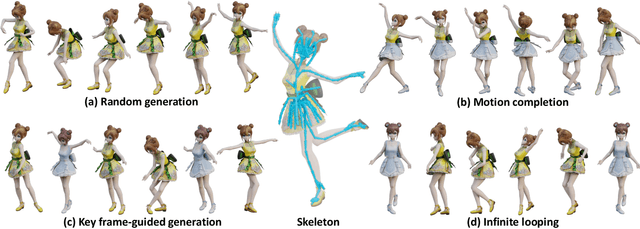


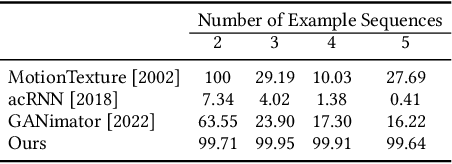
Abstract:We present GenMM, a generative model that "mines" as many diverse motions as possible from a single or few example sequences. In stark contrast to existing data-driven methods, which typically require long offline training time, are prone to visual artifacts, and tend to fail on large and complex skeletons, GenMM inherits the training-free nature and the superior quality of the well-known Motion Matching method. GenMM can synthesize a high-quality motion within a fraction of a second, even with highly complex and large skeletal structures. At the heart of our generative framework lies the generative motion matching module, which utilizes the bidirectional visual similarity as a generative cost function to motion matching, and operates in a multi-stage framework to progressively refine a random guess using exemplar motion matches. In addition to diverse motion generation, we show the versatility of our generative framework by extending it to a number of scenarios that are not possible with motion matching alone, including motion completion, key frame-guided generation, infinite looping, and motion reassembly. Code and data for this paper are at https://wyysf-98.github.io/GenMM/
MoDi: Unconditional Motion Synthesis from Diverse Data
Jun 16, 2022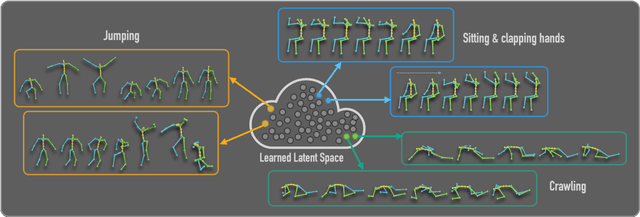
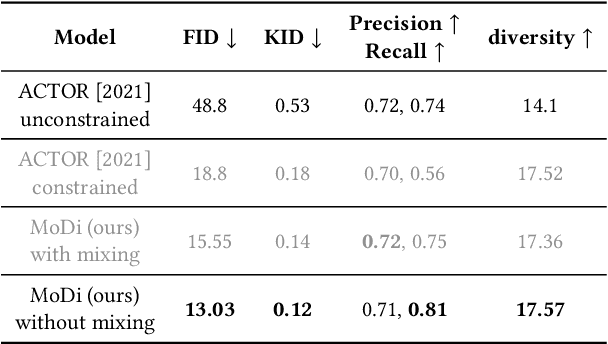

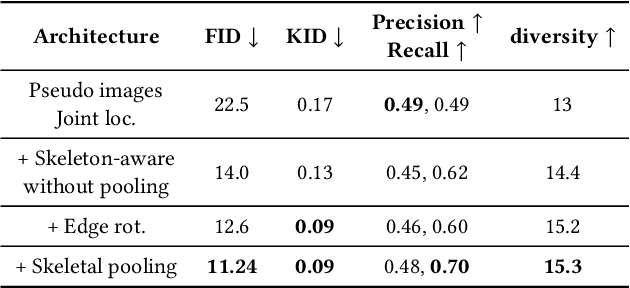
Abstract:The emergence of neural networks has revolutionized the field of motion synthesis. Yet, learning to unconditionally synthesize motions from a given distribution remains a challenging task, especially when the motions are highly diverse. We present MoDi, an unconditional generative model that synthesizes diverse motions. Our model is trained in a completely unsupervised setting from a diverse, unstructured and unlabeled motion dataset and yields a well-behaved, highly semantic latent space. The design of our model follows the prolific architecture of StyleGAN and adapts two of its key technical components into the motion domain: a set of style-codes injected into each level of the generator hierarchy and a mapping function that learns and forms a disentangled latent space. We show that despite the lack of any structure in the dataset, the latent space can be semantically clustered, and facilitates semantic editing and motion interpolation. In addition, we propose a technique to invert unseen motions into the latent space, and demonstrate latent-based motion editing operations that otherwise cannot be achieved by naive manipulation of explicit motion representations. Our qualitative and quantitative experiments show that our framework achieves state-of-the-art synthesis quality that can follow the distribution of highly diverse motion datasets. Code and trained models will be released at https://sigal-raab.github.io/MoDi.
GANimator: Neural Motion Synthesis from a Single Sequence
May 05, 2022


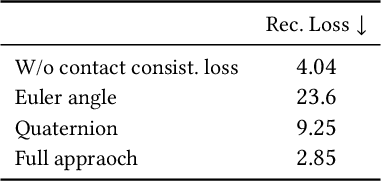
Abstract:We present GANimator, a generative model that learns to synthesize novel motions from a single, short motion sequence. GANimator generates motions that resemble the core elements of the original motion, while simultaneously synthesizing novel and diverse movements. Existing data-driven techniques for motion synthesis require a large motion dataset which contains the desired and specific skeletal structure. By contrast, GANimator only requires training on a single motion sequence, enabling novel motion synthesis for a variety of skeletal structures e.g., bipeds, quadropeds, hexapeds, and more. Our framework contains a series of generative and adversarial neural networks, each responsible for generating motions in a specific frame rate. The framework progressively learns to synthesize motion from random noise, enabling hierarchical control over the generated motion content across varying levels of detail. We show a number of applications, including crowd simulation, key-frame editing, style transfer, and interactive control, which all learn from a single input sequence. Code and data for this paper are at https://peizhuoli.github.io/ganimator.
Learning Skeletal Articulations with Neural Blend Shapes
May 06, 2021



Abstract:Animating a newly designed character using motion capture (mocap) data is a long standing problem in computer animation. A key consideration is the skeletal structure that should correspond to the available mocap data, and the shape deformation in the joint regions, which often requires a tailored, pose-specific refinement. In this work, we develop a neural technique for articulating 3D characters using enveloping with a pre-defined skeletal structure which produces high quality pose dependent deformations. Our framework learns to rig and skin characters with the same articulation structure (e.g., bipeds or quadrupeds), and builds the desired skeleton hierarchy into the network architecture. Furthermore, we propose neural blend shapes--a set of corrective pose-dependent shapes which improve the deformation quality in the joint regions in order to address the notorious artifacts resulting from standard rigging and skinning. Our system estimates neural blend shapes for input meshes with arbitrary connectivity, as well as weighting coefficients which are conditioned on the input joint rotations. Unlike recent deep learning techniques which supervise the network with ground-truth rigging and skinning parameters, our approach does not assume that the training data has a specific underlying deformation model. Instead, during training, the network observes deformed shapes and learns to infer the corresponding rig, skin and blend shapes using indirect supervision. During inference, we demonstrate that our network generalizes to unseen characters with arbitrary mesh connectivity, including unrigged characters built by 3D artists. Conforming to standard skeletal animation models enables direct plug-and-play in standard animation software, as well as game engines.
Skeleton-Aware Networks for Deep Motion Retargeting
May 12, 2020


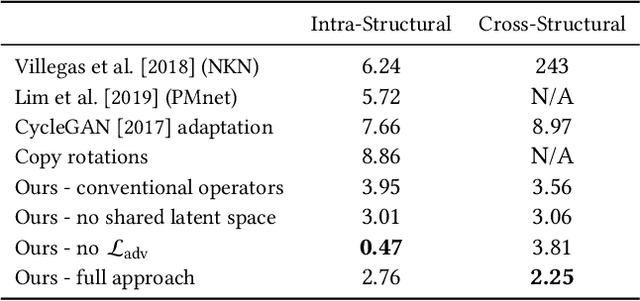
Abstract:We introduce a novel deep learning framework for data-driven motion retargeting between skeletons, which may have different structure, yet corresponding to homeomorphic graphs. Importantly, our approach learns how to retarget without requiring any explicit pairing between the motions in the training set. We leverage the fact that different homeomorphic skeletons may be reduced to a common primal skeleton by a sequence of edge merging operations, which we refer to as skeletal pooling. Thus, our main technical contribution is the introduction of novel differentiable convolution, pooling, and unpooling operators. These operators are skeleton-aware, meaning that they explicitly account for the skeleton's hierarchical structure and joint adjacency, and together they serve to transform the original motion into a collection of deep temporal features associated with the joints of the primal skeleton. In other words, our operators form the building blocks of a new deep motion processing framework that embeds the motion into a common latent space, shared by a collection of homeomorphic skeletons. Thus, retargeting can be achieved simply by encoding to, and decoding from this latent space. Our experiments show the effectiveness of our framework for motion retargeting, as well as motion processing in general, compared to existing approaches. Our approach is also quantitatively evaluated on a synthetic dataset that contains pairs of motions applied to different skeletons. To the best of our knowledge, our method is the first to perform retargeting between skeletons with differently sampled kinematic chains, without any paired examples.
 Add to Chrome
Add to Chrome Add to Firefox
Add to Firefox Add to Edge
Add to Edge